|
The Summiters mountaineering curriculum is comprehensive and flexible.
- Safety and success in mountaineering depend on thorough preparation in all pertinent skill and knowledge areas. Since we do not require any specific prior experience or competence, all participants will be checked out and brought up to speed in every particular.
- On the other hand, time is a precious commodity in this program, as in all climbing expeditions. To avoid redundancy, assignments and exercises will be calibrated to the individual's needs.
Planning and Organization Skills General themes that will be the subject of pre-departure readings, as well as assignments and workshops in Kathmandu:
- Minimum impact techniques
- Expedition preparation: planning and logistics
- Selection and acquisition of gear
- Packing
- Group and expedition dynamics
- Hazard evaluation and response
- Leadership
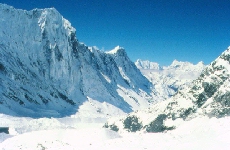 Expedition Planning Protocol One of the exercises to be completed in Kathmandu during the orientation week is the compilation of a protocol for a major Himalayan climbing expedition. For this exercise, we will assume that Gauri Shankar is to be reopened. Our participants will formulate a plan to organize and field the first assault from the Nepali side. This entails working out how to get authorization, deciding what staff and equipment will be necessary, arranging transportation, and formulating a budget. Summiters participants will have to divide up research tasks, make appropriate contacts, and gather all necessary information. The resulting protocol should make it possible for any of our team to organize an expedition at some point in the future without making an additional planning trip to Nepal, and without relying on a locally-based outfitter.
Expedition Planning Protocol One of the exercises to be completed in Kathmandu during the orientation week is the compilation of a protocol for a major Himalayan climbing expedition. For this exercise, we will assume that Gauri Shankar is to be reopened. Our participants will formulate a plan to organize and field the first assault from the Nepali side. This entails working out how to get authorization, deciding what staff and equipment will be necessary, arranging transportation, and formulating a budget. Summiters participants will have to divide up research tasks, make appropriate contacts, and gather all necessary information. The resulting protocol should make it possible for any of our team to organize an expedition at some point in the future without making an additional planning trip to Nepal, and without relying on a locally-based outfitter.
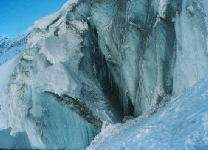 Climbing and Survival Skills These topics will be introduced in readings and workshops before actual climbing exercises. Practical skills will be acquired through hands-on experience in the course of fieldwork and actual climbs.
Climbing and Survival Skills These topics will be introduced in readings and workshops before actual climbing exercises. Practical skills will be acquired through hands-on experience in the course of fieldwork and actual climbs.
- First aid, high altitude medicine, acclimatization, accident site management, emergency response procedures, avalanche response, remote rescue and evacuation
- Meteorology, storm and avalanche forecasting
- Care and use of technical equipment, including snow and ice protection
- Ropework: knots and hitches, leading, top rope, fixing rope, belay, self-belay, rappelling
- Pathfinding: use of GPS, compass, maps; search strategies
- Glacier travel; movement on snow and ice
- Self-arrest, rescue, self-rescue
Know the mountain. Know yourself. This is the key to safe and successful mountaineering. At Summiters, our mission is to develop not only the skills and the knowledge essential to Himalayan climbing, but also to inculcate the habits of mind that will prepare you for any challenge.
Be specific!
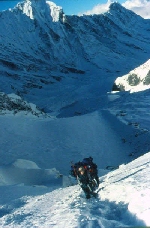 The best place to train for the Himalayas is the Himalayas. Movie-makers may save time and money by using fake footage, shooting Himalayan scenes in Colorado or British Columbia -- someplace close to home. That's okay for them: they're dealing in illusions.
The best place to train for the Himalayas is the Himalayas. Movie-makers may save time and money by using fake footage, shooting Himalayan scenes in Colorado or British Columbia -- someplace close to home. That's okay for them: they're dealing in illusions.
You're not. The key constraints of Himalayan climbing simply are not to be found elsewhere: extreme elevation, monsoonal climate, subcontinental bureaucracy, and all the particularities of the long trek in. Not to mention the panoply of exotic gastro-intestinal ailments. Lack of familiarity with any of these can spell defeat for a costly expedition.
Know yourself. Let's face it: climbing in the Himalayas is not rocket science. Mt. Everest has been described as a long slog, with only a bit of technical climbing at Hillary's Step. Few climbers have to even fix their own ropes. The problems are more elemental: oxygen deprivation, exposure, sudden storms, above all fatigue. Being in good shape is not enough. You have to be able to predict how you will function in this extreme environment. Climbing a moderate Himalayan peak like Pachermo, at just over 20,000', is going to teach you infinitely more about your chances on Everest than climbing the highest mountain on any other continent in the world.
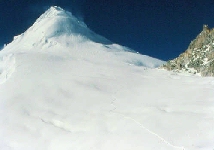 At the conclusion of training, we will cross the notorious Tashi Laptsa pass into Khumbu. Following the southern lateral morain east from Tsho Rolpa, we will cross the glacier to the northern slope, timing our movements to avoid dangerous rockfall. After navigating the icefall leading to the pass, we will camp at over 5750 meters before attempting our most challenging summit: Pachermo! At 6273 m, you will not need oxygen, due to our protracted training and acclimatization, but this assault will definitely test your newly acquired skills. At the conclusion of training, we will cross the notorious Tashi Laptsa pass into Khumbu. Following the southern lateral morain east from Tsho Rolpa, we will cross the glacier to the northern slope, timing our movements to avoid dangerous rockfall. After navigating the icefall leading to the pass, we will camp at over 5750 meters before attempting our most challenging summit: Pachermo! At 6273 m, you will not need oxygen, due to our protracted training and acclimatization, but this assault will definitely test your newly acquired skills.
Following our summit bid, we will descend into Sagarmatha National Park. At Thame our program will end, but you will have the opportunity to trek throughout Khumbu, participate in the Namche Conference and other events planned for the Everest Jubilee (50 years since the first ascent), or simply return to Kathmandu. Whatever your decision, you will have gained the necessary knowledge and skills to plan and execute your own mountaineering expeditions throughout the world.
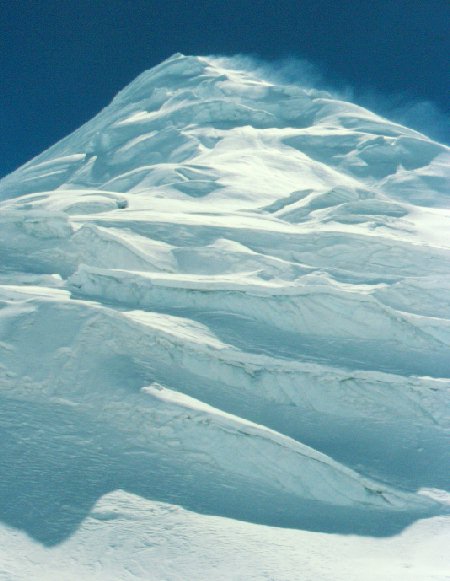
Pachermo!
|



 Expedition Planning Protocol One of the exercises to be completed in Kathmandu during the orientation week is the compilation of a protocol for a major Himalayan climbing expedition. For this exercise, we will assume that Gauri Shankar is to be reopened. Our participants will formulate a plan to organize and field the first assault from the Nepali side. This entails working out how to get authorization, deciding what staff and equipment will be necessary, arranging transportation, and formulating a budget. Summiters participants will have to divide up research tasks, make appropriate contacts, and gather all necessary information. The resulting protocol should make it possible for any of our team to organize an expedition at some point in the future without making an additional planning trip to Nepal, and without relying on a locally-based outfitter.
Expedition Planning Protocol One of the exercises to be completed in Kathmandu during the orientation week is the compilation of a protocol for a major Himalayan climbing expedition. For this exercise, we will assume that Gauri Shankar is to be reopened. Our participants will formulate a plan to organize and field the first assault from the Nepali side. This entails working out how to get authorization, deciding what staff and equipment will be necessary, arranging transportation, and formulating a budget. Summiters participants will have to divide up research tasks, make appropriate contacts, and gather all necessary information. The resulting protocol should make it possible for any of our team to organize an expedition at some point in the future without making an additional planning trip to Nepal, and without relying on a locally-based outfitter.
 Climbing and Survival Skills These topics will be introduced in readings and workshops before actual climbing exercises. Practical skills will be acquired through hands-on experience in the course of fieldwork and actual climbs.
Climbing and Survival Skills These topics will be introduced in readings and workshops before actual climbing exercises. Practical skills will be acquired through hands-on experience in the course of fieldwork and actual climbs.
 The best place to train for the Himalayas is the Himalayas. Movie-makers may save time and money by using fake footage, shooting Himalayan scenes in Colorado or British Columbia -- someplace close to home. That's okay for them: they're dealing in illusions.
The best place to train for the Himalayas is the Himalayas. Movie-makers may save time and money by using fake footage, shooting Himalayan scenes in Colorado or British Columbia -- someplace close to home. That's okay for them: they're dealing in illusions.  At the conclusion of training, we will cross the notorious Tashi Laptsa pass into Khumbu. Following the southern lateral morain east from Tsho Rolpa, we will cross the glacier to the northern slope, timing our movements to avoid dangerous rockfall. After navigating the icefall leading to the pass, we will camp at over 5750 meters before attempting our most challenging summit: Pachermo! At 6273 m, you will not need oxygen, due to our protracted training and acclimatization, but this assault will definitely test your newly acquired skills.
At the conclusion of training, we will cross the notorious Tashi Laptsa pass into Khumbu. Following the southern lateral morain east from Tsho Rolpa, we will cross the glacier to the northern slope, timing our movements to avoid dangerous rockfall. After navigating the icefall leading to the pass, we will camp at over 5750 meters before attempting our most challenging summit: Pachermo! At 6273 m, you will not need oxygen, due to our protracted training and acclimatization, but this assault will definitely test your newly acquired skills. 